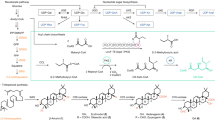Abstract
Factor IX (Christmas factor), a vitamin K-dependent plasma protein made in the liver, functions in the middle phase of the intrinsic pathway of blood coagulation1. A functional deficiency of factor IX underlies haemophilia B, a chromosome X-linked recessive disease for which the major therapeutic approach is replacement treatment using factor IX concentrates. The cloning and characterization of the gene for human factor IX2–4 would mean that human factor IX could be produced in greater yield and purity through using recombinant DNA techniques5. We have now used a human factor IX cDNA clone4, inserted into a vaccinia virus-derived vector, to infect human hepatoma cells which normally produce no factor IX6, and mouse fibroblasts. Fully active factor IX was produced by the hepatoma cells, whereas the fibroblasts produced a protein less active than natural factor IX, even in the presence of high levels of vitamin K. Human factor IX is extensively post-translationally modified, and thus represents probably the most complex protein produced in active form by recombinant DNA techniques to date. Our study also illustrates the potential of vaccinia virus-based vectors for expressing significant amounts of complex, clinically useful proteins in eukaryotic cells, in addition to its already demonstrated usefulness for producing live recombinant vaccines7–9.
This is a preview of subscription content, access via your institution
Access options
Subscribe to this journal
Receive 51 print issues and online access
$199.00 per year
only $3.90 per issue
Buy this article
- Purchase on Springer Link
- Instant access to full article PDF
Prices may be subject to local taxes which are calculated during checkout
Similar content being viewed by others
References
Hedner, U. & Davie, E. W. in Hemostasis and Thrombosis (eds Colman, R. W., Hirsh, J., Marder, V. J. & Salzmann, E. W.) 29–38 (Lippincott, Philadelphia, 1982).
Choo, K. H., Could, K. J., Rees, D. J. G. & Brownlee, G. G. Nature 299, 178–180 (1982).
Kurachi, K. & Davie, E. W. Proc. natn. Acad. Sci. U.S.A. 79, 6461–6464 (1982).
Jaye, M. et al. Nucleic Acids Res. 11, 2325–2335 (1983).
Bloom, A. L. Nature 303, 474–475 (1983).
Fair, D. S. & Bahnak, B. R. Blood 64, 194–204 (1984).
Smith, G. L., Hackett, M. & Moss, B. Nature 302, 490–495 (1983).
Panicali, D., Davis, S. W., Weinberg, R. L. & Paoletti, E. Proc. natn. Acad. Sci. U.S.A. 80, 7155–7159 (1983).
Kieny, M.-P. et al. Nature 312, 163–166 (1984).
Chavin, S. I. & Weidner, S. M. J. biol. Chem. 259, 3387–3390 (1984).
Fernlund, P. & Stenflo, J. J. biol Chem. 258, 12509–12512 (1983).
McMullen, B. A., Fujikawa, K. & Kisiel, W. Biochem. biophys. Res. Commun. 115, 8–14 (1983).
Sugo, T., Bjørk, I., Holmgren, A. & Stenflo, J. J. biol Chem. 259, 5705–5710 (1984).
Morita, T., Isaacs, B. S., Esmon, C. T. & Johnson, A. E. J. biol. Chem. 259, 5698–5704 (1984).
Malhotra, O. P. Thromb. Res. 15, 427–437, 439–448, 449–463 (1979).
Caen, J., Larrieu, M. J. & Samama, M. in L' Hémostase (Expansion Scientinque, Paris, 1975).
Lathe, R., Hirth, P., Dewilde, M., Harford, N. & Lecocq, J.-P. Nature 280, 473–474 (1980).
Laemli, V. Nature 227, 680–685 (1970).
Author information
Authors and Affiliations
Rights and permissions
About this article
Cite this article
de la Salle, H., Altenburger, W., Elkaim, R. et al. Active γ-carboxylated human factor IX expressed using recombinant DNA techniques. Nature 316, 268–270 (1985). https://doi.org/10.1038/316268a0
Received:
Accepted:
Issue Date:
DOI: https://doi.org/10.1038/316268a0
This article is cited by
-
Approaches for recombinant human factor IX production in serum-free suspension cultures
Biotechnology Letters (2016)
-
Recombinant human protein C, protein S and thrombomodulin as antithrombotics
Perspectives in Drug Discovery and Design (1994)
-
The live vector approach—viruses
World Journal of Microbiology and Biotechnology (1991)
Comments
By submitting a comment you agree to abide by our Terms and Community Guidelines. If you find something abusive or that does not comply with our terms or guidelines please flag it as inappropriate.



